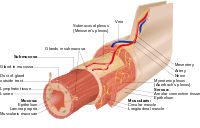Mucous membrane
| Mucous membrane | |
|---|---|
 Histological section taken from the gastric antrum, showing the mucosa of the stomach | |
| Details | |
| Precursor | ectoderm |
| Identifiers | |
| Latin | tunica mucosa |
| MeSH | D009092 |
 |
| This article is one of a series on the |
| Gastrointestinal wall |
|---|
|
General structure |
|
Specific |
|
Organs |
A mucous membrane or mucosa is a membrane that lines various cavities in the body and surrounds internal organs. It consists of one or more layers of epithelial cells overlying a layer of loose connective tissue. It is of ectodermal origin and is continuous with the skin at various body openings such as the eyes, ears, nose, mouth, the urethral opening and the anus, frenulum of tongue, tongue. Some mucous membranes secrete mucus, a thick protective fluid. The function of the membrane is to stop pathogens and dirt from entering the body and to prevent bodily tissues from becoming dehydrated.
Structure
The mucous membrane is a lining of mostly ectodermal origin. It consists of an epithelium (one or more layers of epithelial cells)[1] and an underlying lamina propria of loose connective tissue. Mucosae line various cavities of the body that are either externally exposed to the environment or are internal organs, and the mucous membranes ensure that the underlying lamina propria of connective tissue remains moist. They are at several places contiguous with skin: at the nostrils, the lips of the mouth, the eyelids, the ears, the trachea, the stomach, the genital area, and the anus.[1]
In the female, the glans clitoridis and the clitoral hood have mucous membranes.[2] In the male, the glans penis (the head of the penis) and the inner layer of the foreskin have mucous membranes.[3] The urethra is also lined with a mucous membrane.[2]
Examples
Some examples include:
- Bronchial mucosa and the lining of vocal folds
- Endometrium: the mucosa of the uterus
- Esophageal mucosa
- Gastric mucosa
- Intestinal mucosa
- Nasal mucosa
- Olfactory mucosa
- Oral mucosa
- Penile mucosa
- Vaginal mucosa
- Frenulum of tongue
- Tongue
Function
- Mucus prevents pathogens and dirt from entering the body and prevents bodily tissue from losing moisture. Mucous membranes are rather delicate; they are able to absorb a number of substances and toxins but are vulnerable regarding pain. If the lining is torn or broken, mucus is incapable of performing its roles of preventing infection and retaining tissue moisture levels.[4] Some mucous membranes are involved with digestion in the absorption of insoluble food molecules and secretion (releasing chemicals from glands).[5] The thick fluid secreted by some mucous membranes and/or associated glands is termed mucus. The mucus can be protective.[6]
See also
References
- 1 2 "Mucous membrane". Encyclopedia Britannica. Retrieved 1 August 2015.
- 1 2 Edward Rigby (1841). A System of Midwifery: With numerous wood cuts. With notes and additional illustrations. Lea & Blanchard. pp. 46–.
- ↑ "Anatomy and Function" (PDF). coloradonocirc. Retrieved 1 August 2015.
- ↑ "What is a Mucous Membrane?". wiseGeek. Retrieved 1 August 2015.
- ↑ "The Role of the Mucus Barrier in Digestion" (PDF). doi:10.1007/s13228-012-0021-1.
- ↑ "Mucus". Encyclopedia Britannica. Retrieved 1 August 2015.
External links
- Mucous Membrane at the US National Library of Medicine Medical Subject Headings (MeSH)